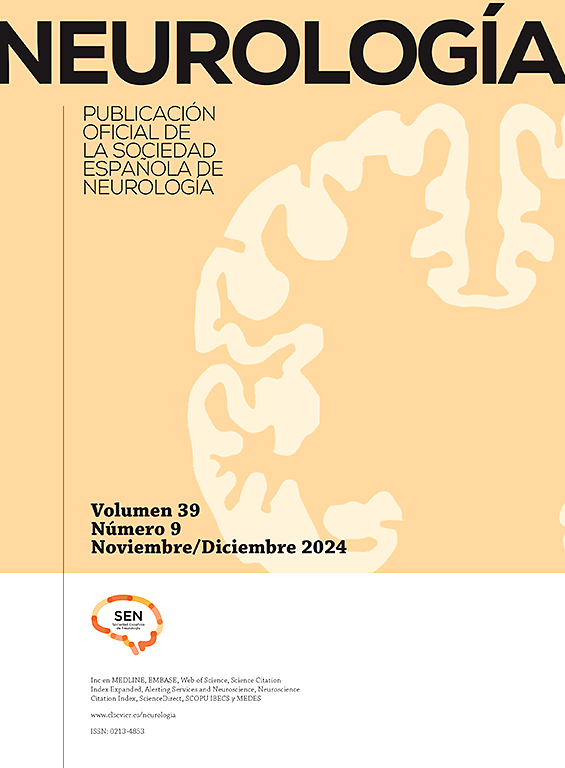A single institution series of intravascular lymphoma: Neurological manifestations and neuroimaging findings
IF 3.1
4区 医学
Q2 CLINICAL NEUROLOGY
引用次数: 0
Abstract
Background
Intravascular lymphoma (IVL) is a diffuse large B-cell lymphoma characterized by occlusion of small vessels of organs by malignant cells with special tropism for the nervous system. Our purpose has been to describe a series of IVL diagnosed in our center and to compare the results with those of the literature.
Methods
A retrospective review of the clinical, imaging, and pathological data of consecutive patients with IVL in the last 20 years was performed. Pathology department database was the source of patient identification.
Results
We identified six cases (three males and three females), with a median age at diagnosis of 54.64 (interquartile range (IR) 51.93–59.67). Five of them (83.3%) debuted with neurological manifestations. The median time to diagnosis was 3.77 months. On cranial magnetic resonance imaging, the findings consisted of multiple white matter and corpus callosum lesions (some of them with enhancement or hemorrhagic foci) and multifocal infarcts with hemorrhagic transformation. One patient displayed leptomeningeal branch aneurysms. A proton emission tomography with fluorodeoxyglucose (PET-FDG) was performed in five patients showing areas of elevated metabolism in all of them. Four patients underwent targeted biopsy, which allowed the diagnosis of IVL to be established in three. Four of the five patients who received treatment remained in complete remission with a median progression-free survival of 69.62 months (IR 49.11–162.82).
Conclusions
IVL begins frequently with neurological manifestations, which must alert the neurologist to be aware of this entity. PET-FDG helps to identify biopsy-accessible lesions and facilitate early diagnosis of IVL.
单一机构的一系列血管内淋巴瘤:神经学表现和神经影像学发现
血管性淋巴瘤(IVL)是一种弥漫性大b细胞淋巴瘤,其特征是恶性细胞阻塞器官的小血管,并对神经系统有特殊的倾向。我们的目的是描述本中心诊断的一系列IVL,并将结果与文献进行比较。方法回顾性分析近20年来连续发生的IVL患者的临床、影像学和病理资料。病理科数据库是患者身份识别的来源。结果6例患者(男3例,女3例),诊断时中位年龄54.64岁(四分位间距(IR) 51.93 ~ 59.67)。其中5例(83.3%)首次出现神经系统症状。中位诊断时间为3.77个月。颅磁共振成像显示多发性白质和胼胝体病变(其中一些有强化或出血性灶)和多灶性梗死伴出血性转化。1例患者显示脑脊膜分支动脉瘤。对5例患者进行了氟脱氧葡萄糖质子发射断层扫描(PET-FDG),显示所有患者的代谢区域均升高。4例患者行靶向活检,其中3例诊断为IVL。接受治疗的5名患者中有4名保持完全缓解,中位无进展生存期为69.62个月(IR 49.11-162.82)。结论sivl常以神经系统表现开始,必须提醒神经科医生注意这一实体。PET-FDG有助于识别活检可及的病变,促进IVL的早期诊断。
本文章由计算机程序翻译,如有差异,请以英文原文为准。
求助全文
约1分钟内获得全文
求助全文
来源期刊

Neurologia
医学-临床神经学
CiteScore
5.90
自引率
2.60%
发文量
135
审稿时长
48 days
期刊介绍:
Neurología es la revista oficial de la Sociedad Española de Neurología y publica, desde 1986 contribuciones científicas en el campo de la neurología clínica y experimental. Los contenidos de Neurología abarcan desde la neuroepidemiología, la clínica neurológica, la gestión y asistencia neurológica y la terapéutica, a la investigación básica en neurociencias aplicada a la neurología. Las áreas temáticas de la revistas incluyen la neurologia infantil, la neuropsicología, la neurorehabilitación y la neurogeriatría. Los artículos publicados en Neurología siguen un proceso de revisión por doble ciego a fin de que los trabajos sean seleccionados atendiendo a su calidad, originalidad e interés y así estén sometidos a un proceso de mejora. El formato de artículos incluye Editoriales, Originales, Revisiones y Cartas al Editor, Neurología es el vehículo de información científica de reconocida calidad en profesionales interesados en la neurología que utilizan el español, como demuestra su inclusión en los más prestigiosos y selectivos índices bibliográficos del mundo.
 求助内容:
求助内容: 应助结果提醒方式:
应助结果提醒方式:


